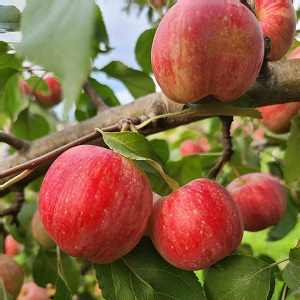Crabapple : CHESTNUT Large Semi-Dwarf (B118) (Orchard Grade)
$37.95
An 'orchard grade' is a tree that may be somewhat shorter, slightly crooked, or a bit scratched, or for some other reason is not a perfect front lawn specimen. These trees will work just as well in an orchard as a first or number one would, since they still produce the very same fruit.
Fabulous, complex flavour in a golf ball-sized fruit! Chestnut has been known to win apple taste tests with its crisp, sweet yellow flesh that is nutty with a hint of vanilla. Reddish bronze fruit hangs on the tree long after ripening and is ideal for dessert, cider, pickling or sauce. With large, aromatic white blossoms, this disease resistant variety makes a great ornamental landscaping addition.
SEMI-FERTILE* | ZONE 3 | HARVEST: EARLY SEPT.
3 reviews for Crabapple : CHESTNUT Large Semi-Dwarf (B118) (Orchard Grade)
Only logged in customers who have purchased this product may leave a review.
Growing Tips
Besides selecting the most disease resistant varieties, there are
a few simple things to do to have better apples.
- Fertilize under the outer edges of your trees. There are no feeder roots next to the trunk. A well fed tree stays healthier. (Adequate calcium in the soil also helps so that apples keep longer.)
- Pick up fallen fruit and compost, dispose of, or feed to livestock (where possible).
- Rake up leaves in the fall and compost them away from the orchard.
- Prune trees to encourage light and air to reach the inside of the tree.
- Provide bird nesting sites near your orchard. A variety of orchard companion type plants will attract native pollinator insects and also encourage birds to come and eat insect pests.






Bradley L Sweiger (verified owner) –
Leafing out and very lush. Even has one little clump of blossom buds, so must be very healthy.
Beatrice Ballantyne (verified owner) –
Arrived quickly. Nicely boxed. Tree was bare from winter sleep. Planted and watered as per directions. After two weeks tree is doing well despite our current dry conditions in Saskatchewan. Has a nice set of leaves on it and found it now blossoming.
DOUGLAS DANIELS (verified owner) –
Great!